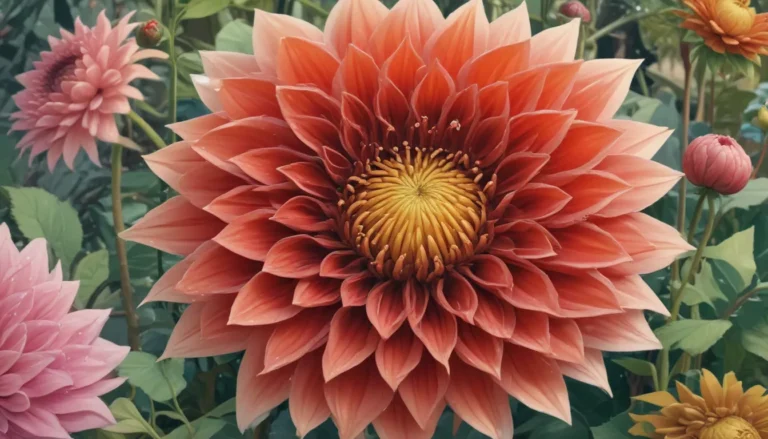A Comprehensive Guide to Growing and Caring for Dianthus Flowers

Dianthus flowers, also known as pinks, are a favorite in cottage gardens with their mounding growth and fragrant blooms. With over 300 species, these plants are native to various regions including Europe, Asia, North Africa, and North America. From herbaceous perennials to hardy annuals, the Dianthus genus offers a wide range of options for gardeners.
Here’s what you’ll learn in this guide:
- Cultivation and History
- How to Grow Dianthus Flowers
- Propagation
- Managing Pests and Disease
- Pruning and Maintenance
- Species to Select
- Quick Reference Growing Guide
Let’s dive into the colorful world of Dianthus flowers!
Cultivation and History
Dianthus flowers have a rich history that dates back to Ancient Greek and Roman times, where they were revered for their beauty. The name “Dianthus” is derived from the Greek words dios (god) and anthos (flower), translating to “flower of the gods.” Legends and myths surrounding these blooms add to their mystique and charm.
Notable species within the Dianthus genus include:
- Carnations (D. caryophyllus)
- Cheddar Pinks (D. gratianopolitanus)
- China Pinks (D. chinensis)
- Garden Pinks (D. plumarius)
- Large Pinks (D. superbus)
- Sweet Williams (D. barbatus)
Pinks and carnations, in particular, have been cherished for their longevity as cut flowers and their captivating fragrance. They continue to be popular choices for gardeners looking to add a touch of elegance to their outdoor spaces.
How to Grow Dianthus Flowers
Dianthus flowers thrive in full sun and well-drained soil, making them suitable for a variety of garden settings. Here are some essential tips for growing these beautiful blooms:
Planting and Care Tips:
- Ensure your Dianthus plants receive at least 6 hours of sunlight daily.
- Provide well-drained soil enriched with compost.
- Water new plants weekly and fertilize during the growing season.
- Deadhead spent flowers to encourage continuous blooming.
- Mulch plants in winter for protection from frost.
Propagation Methods:
- Start seeds indoors before the last frost, or direct sow in the garden.
- Take stem cuttings to propagate new plants.
- Overwinter seedlings or cuttings for spring planting.
Managing Pests and Disease
While Dianthus flowers are relatively disease-resistant, they may encounter common garden pests such as aphids and carnation flies. Here are some tips for managing pests and diseases:
- Control aphids with a sharp spray of water or introduce ladybugs as natural predators.
- Combat carnation flies with garlic companion planting or garlic tea.
- Prevent rust and powdery mildew by providing adequate ventilation and removing infected plant matter.
Dianthus Species to Select
When choosing Dianthus varieties for your garden, consider factors like height, color, and fragrance. Here are some popular options to explore:
- ‘Cancan Scarlet’ Carnations: Known for their long stems and bold fragrance.
- ‘Telstar’ Dianthus Seeds: A hybrid series with colorful blooms.
- ‘Pink Beauty’ Sweet Williams: Clusters of vibrant, sweet-smelling flowers.
Experiment with different Dianthus species to create a diverse and visually appealing garden display.
Quick Reference Growing Guide
Here’s a quick overview of key information for growing Dianthus flowers:
- Plant Type: Herbaceous perennial; a few species are annual
- Hardiness (USDA Zone): 3-9
- Exposure: Full sun
- Height: 4-24 inches depending on species
- Spacing: 6-12 inches depending on species
- Water Needs: Moderate
- Maintenance: Moderate
Use this guide as a reference for selecting, planting, and caring for your Dianthus plants.
In Closing
Dianthus flowers, with their colorful petals and delightful fragrance, are a wonderful addition to any garden. By following the tips outlined in this guide, you can successfully cultivate these blooms and enjoy their beauty throughout the growing season.
Experiment with different Dianthus species, propagation methods, and care techniques to create a vibrant and thriving garden filled with these charming flowers.
Whether you’re a novice gardener or an experienced horticulturist, Dianthus plants offer endless possibilities for creativity and enjoyment in your outdoor space. Give these lovely blooms a try and watch your garden come to life with their beauty and fragrance.
Happy gardening!





